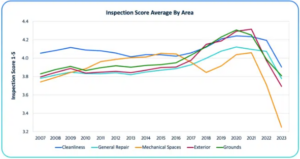Colleges and universities are trudging through inflationary construction costs to successfully reinvest in their existing facilities as students’ interactions with the campus community change in an ever-digitalized world, suggests data from the 11th edition of the State of Facilities in Higher Education report.
Gordian, a facility and construction management leader, analyzed its extensive higher education database, conducted qualitative research on campuses and spoke with facilities services leaders to examine how colleges and universities are managing their physical space three years removed from the disruption of the pandemic. Its results were comprised of studying 43,000 campus buildings and more than $13.5 billion in capital and operating budgets.
School expenditures on existing infrastructure grew 26% since last year and 33% since 2021, the report found. Gordian suggested that this investment increase shows that higher education has once again found its appreciation for protecting its physical assets and curating students’ campus experience. At the same time, campus expansion has remained flat for a third year as enrollment has ebbed. Plus, how current students, faculty, administration, and overall staff engage with the campus has changed.
“Employees work remotely. Research takes place just as often in a student’s room as in the library,” the report reads. “The amount of space needed for the same number of students appears to be shrinking.”
Challenges of facility reinvestment
Despite schools showing a hunger to reinvest in their campuses, the spending power of every dollar has significantly decreased due to inflation and increased wages. Specifically, the cost of building supplies and construction services has increased by nearly 20% since 2019. Despite increased investment efforts, the gap between school expenditure on facilities and those with unmet needs still hovers around 34%. In other words, one in every three dollars of need is going unmet, the report found.
Furthermore, pandemic-induced staffing challenges are hurting institutions’ ability to maintain upkeep. As the number of public maintenance workers shrinks, the gross square feet they are expected to cover has expanded to 111,000, a 32% increase in the past two decades.
Consequently, buildings are showing a greater rate of deterioration and a higher prevalence of obvious leaks, failed or failing equipment, and a general repair decline. Qualitative research conducted by Gordian researchers found that its facilities’ exterior scores dropped 15% and mechanical space scores fell 20%.

Nearly two-thirds of respondents (61%) said they faced vacancies in more than 5% of their staff positions. Staffing shortages will possibly increase in the coming years, as an estimated 40% of current building industry workers will retire by 2030, according to the National Center for Construction Education and Research.
More from UB: This nonprofit commits to erasing college outcome disparities by 2040
Why campuses are still vital in today’s digital era
One may be skeptical about the importance of investing in one’s physical space as the future of higher education looks more digitized. However, Minnesota state institutions are seeking over a half billion dollars in renovations, and Purdue cleared a $1.3 billion plan on facility renovation and construction last year.
Gerardo de los Santos, vice president for community college relations at National University, believes colleges and universities should adopt the notion of the “hybrid campus.” While fewer classes will be offered in a physical space in the coming years (resulting in fewer students), institutions still need to address student needs with in-person tutoring, academic coaching and in-person assistance with admissions, registration and financial aid.
The college campuses of the future won’t sprawl over multiple acres like they do today, nor will they exist solely in the metaverse,” he said in a November 2023 University Business column. “Instead, they will be optimized for a modern learning experience that gives students exactly what they need—and where they need it.”
Additionally, schools can shift to evaluating their facilities as muli-use to create dynamic, flexible learning environments. For example, Florida Atlantic University’s Stiles-Nicholson Brain Institute invites interdisciplinary research in neuroscience and data science to tackle brain disorders such as Alzheimer’s disease, autism, addiction and brain cancer.







